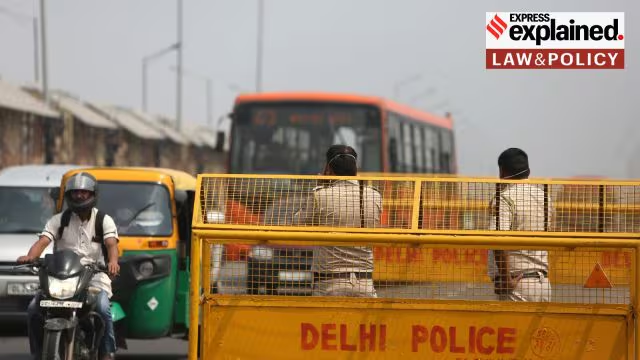Description

Copyright infringement not intended
Picture Courtesy: https://indianexpress.com/article/explained/explained-law/sc-history-sheet-police-amanatullah-khan-9322795/
Context: Police maintain detailed records (history sheets) on individuals suspected of criminal activity, categorised by offence types and threat levels.
What is a History Sheet?
- In Indian law enforcement, a history sheet is a comprehensive record maintained by the police for individuals deemed to pose a threat to public safety due to their past criminal activity. It serves as a centralised record for tracking known offenders and monitoring their movements.
Initiating History Sheeting
The process of creating a history sheet varies slightly based on individual state police rules, but some of the general steps involve:
- The Station House Officer(SHO) who heads a police station identifies a person with a significant criminal history or suspected involvement in ongoing criminal activities.
- A comprehensive report is compiled. This report includes:
- Personal Information: The individual's name, aliases (if any), address, and physical description with a focus on distinctive features.
- Associates and Connections: Information about relatives, friends, and associates whom the individual might collaborate with or seek refuge from.
- Financial Status: Details of any owned property and livelihood to assess their financial situation and ability to support criminal activities.
- Approval Process: The compiled report is submitted to senior police officials like the Superintendent of Police (SP) or Assistant Commissioner of Police (ACP) for review and approval.
- History Sheet Creation: Upon approval, a formal history sheet is created and maintained for the individual.
Information Included in a History Sheet
As per the Punjab Police Rules (1934), a history sheet typically contains the following details:
- Physical Description: A detailed description of the individual's appearance, focusing on any unique physical features that could aid identification.
- Relationships and Connections: Information about associates, relatives, and anyone they might hide with to evade police. This helps authorities track potential accomplices or locations where the individual might be found.
- Financial Status: Details of owned property and livelihood to assess their financial situation. This can be used to identify any discrepancies between their lifestyle and reported income, potentially indicating involvement in illegal activities.

Types of History Sheets
Police may categorise history sheets based on the perceived threat level and type of criminal activity:
- KD (Known Depredators): These sheets are for criminals convicted of serious offences like robbery, dacoity (gang robbery), or burglary.
- Rowdy sheets: These sheets are for individuals involved in habitual breaches of peace or violence.
- Suspect sheets: These sheets are for individuals with a single conviction for theft or burglary.
- Other categories: Depending on the state, additional sheets might exist for members of organised crime or "budding criminals" identified as potential threats based on police assessment.
- Automatic History Sheeting: In specific situations, history sheets may be automatically opened for individuals:
- Conviction for Serious Crimes: Following a conviction for serious offences like robbery, dacoity, or burglary, a history sheet may be automatically created.
- Habitual Offenders: Individuals with a pattern of repeated offences may be automatically history-sheeted.
- Release from Life Imprisonment: Upon release from life imprisonment for specific financial crimes, a history sheet might be created to monitor potential future activities.
Origin and Controversy
- The term "history sheet" first appeared in the Punjab Police Rules (1934). These rules allow opening sheets for individuals suspected of habitual criminal activity, even without convictions.
- Critics argue that this practice is discriminatory and resembles colonial-era profiling of "criminal tribes." The concept raises concerns about potential misuse and biased profiling based on caste or other prejudices.
Recent Developments and the Supreme Court's Role:
- The Supreme Court of India, while recently rejecting an appeal challenging history sheeting, issued a significant judgement. They cautioned against prejudiced profiling based on caste or other biases and emphasised ensuring the dignity and privacy of innocent family members not involved in criminal activity. This judgement highlights the court's growing scrutiny of potential biases within the practice.
Conclusion
- History sheeting remains a contentious practice in India. While it helps track potential threats, concerns exist about fairness, potential misuse, and the impact on innocent family members. The Supreme Court's recent judgement and the Delhi Police's updated guidelines aim to address some of these concerns. Moving forward, ensuring a fair and objective implementation of history sheeting that protects individual rights and avoids biased profiling remains a challenge.
Source:
Indian Express
Indiankanoon
|
PRACTICE QUESTION
Q. The Supreme Court of India has been known to exercise its power of judicial review and public interest litigation (PIL) to address issues of social justice and human rights. However, some argue that this activism oversteps the boundaries of the judiciary's role. How can the court strike a balance between upholding the rule of law and addressing social inequalities?
|










